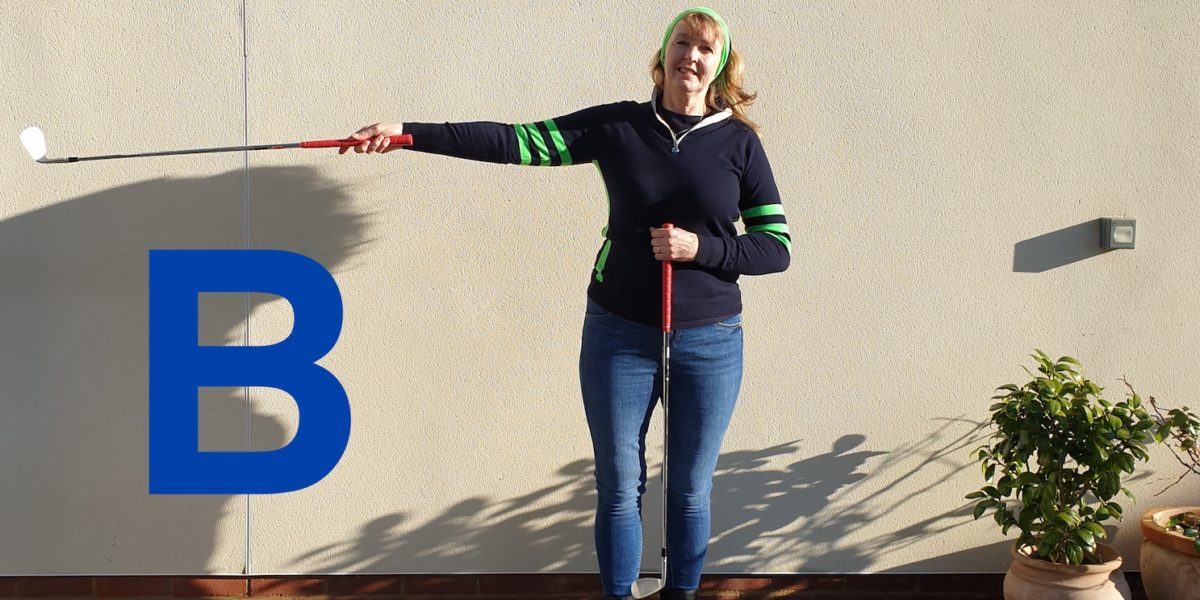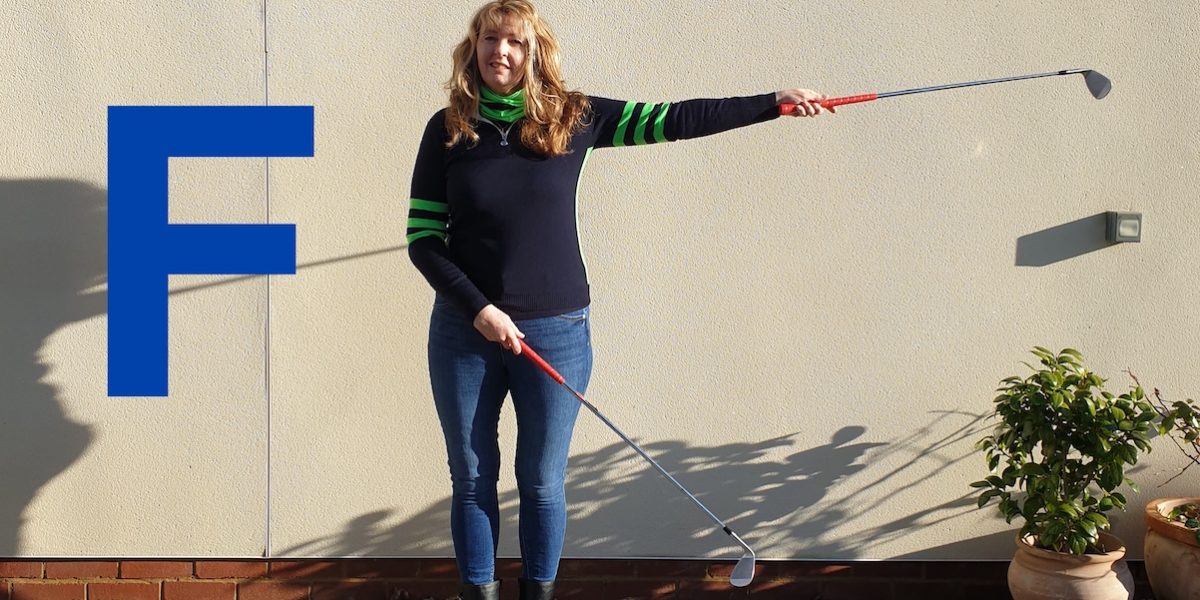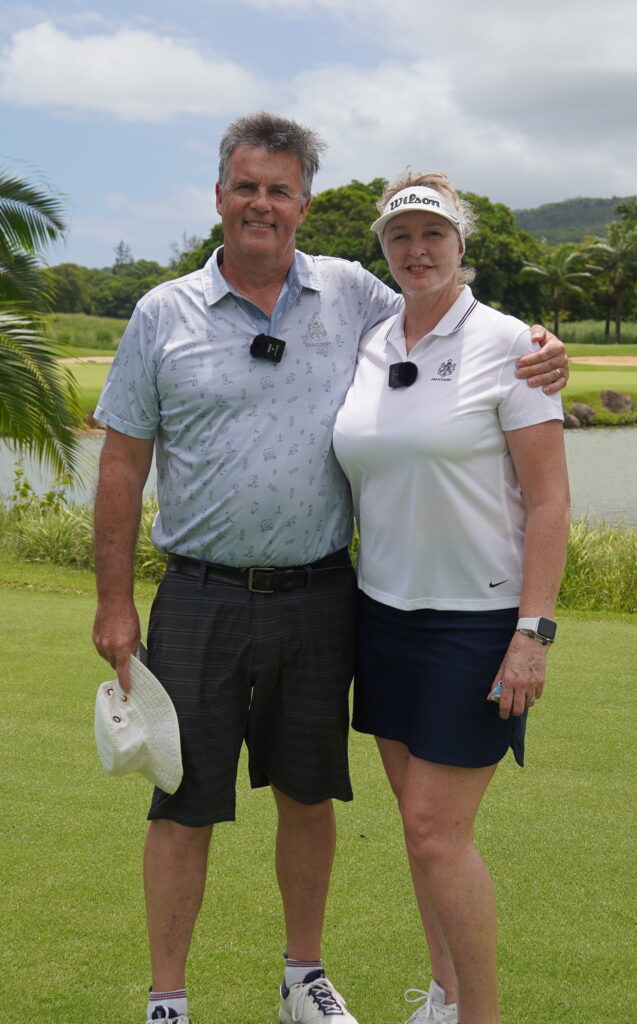
B – Blairgowrie
GB&I Golf Course Review – Z to A
I am showcasing one golf club a day across GB & I over 26 days – in reverse alphabetical order. Full write up and more images can be found on http://golfgurugroup.blogspot.com.
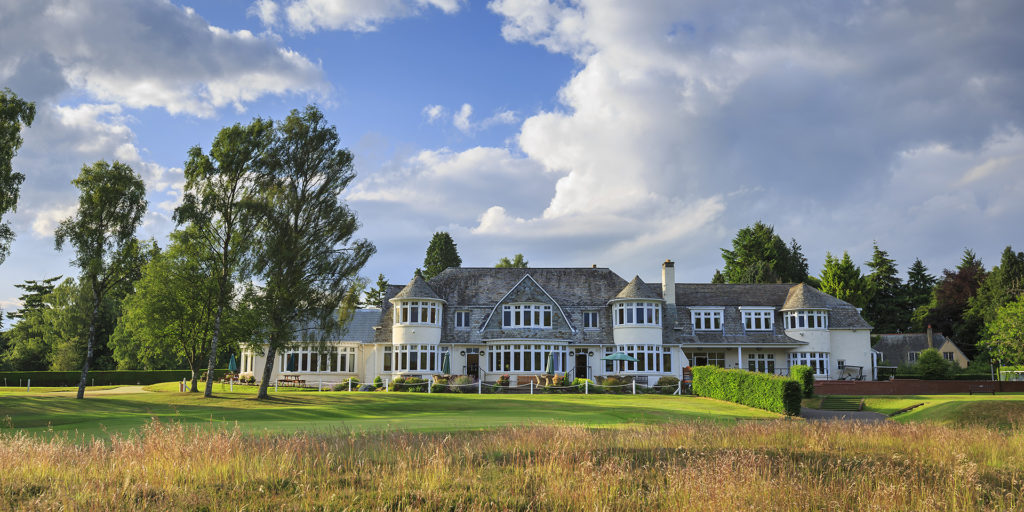
Blairgowrie; Rosemount Course
Golf Course Road, Blairgowrie, Perthsire, PH10 6LG
Blairgowrie means ‘Plain of Gowrie’ in Scottish Gaelic. It’s name pops up all over the world; in Australia, or where I first heard it, in South Africa. I’m sure there are others too. The one I am talking about is in Perthshire, Scotland. Being so close to exceptional links courses, playing Blairgowrie offers a great, yet equally tough golfing experience. Usually without the buffeting wind!

In 1889 a piece of land
Was purchased from the Marchiness of Lansdown by Black Loch. Nine holes were built with a further nine scheduled for work in 1914. At a cost of £3,000 Alistair MacKenzie was bought in to do this job. Mackenzie is probably best known for his work at Augusta, Cypress Point and Royal Melbourne. However the Great War delayed opening until 1927. In 1930 James Braid was appointed to add a further eight holes to the MacKenzie design. He also did some bunker work and I’m sure much more! The Wee Course at Blairgowrie is the original 9 holes. I played the Wee Course and would definitely recommend that too.
You could say two great designers of the time put their mark on this course. Initially called Lansdown, it was later renamed Rosemount. Another 18 holes designed by Peter Alliss and Dave Thomas in the 1970’s was called Lansdown.
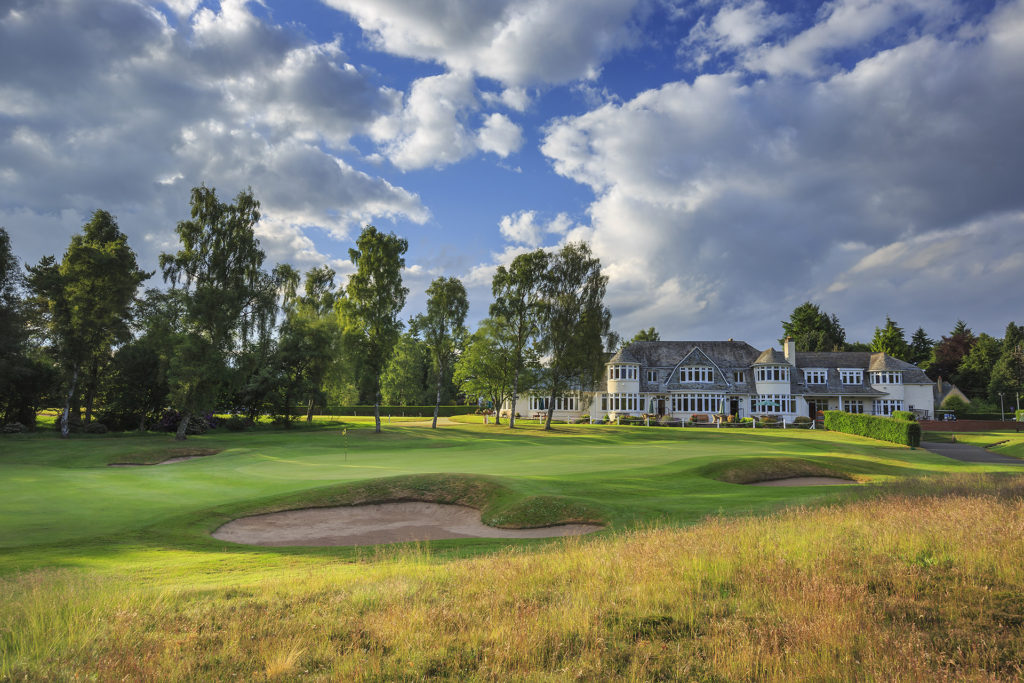
Credit to a golf club
That doesn’t rest on its laurels with it’s desire to continually improve. As close as year 2000 Donald Steel did some work on the first green. Holes 6 and 7 have also recently been remodelled to bring back some of the MacKenzie influence and style.
Hole 6 is a par 3 SI 18/6 171/189 yards. With a sloping green back to front it is the longest green on the course. Add a couple of dimples in the front of the green for good measure means club selection and commitment are key.
Consulting my notes; hole number 7 has a ‘hashtag nightmare’ in the margin. This made me giggle as that’s what I clearly thought at the time when referencing the pin position!

An established woodland course
With a huge dollop of heathland thrown in for good measure. Carved out of scots pines, silver birch and enough heather to bring everyone good luck, except when playing golf. It isn’t unusual to see red squirrels and roe deer wandering around this peaceful setting.
The day I played it was a bit grey and miserable. You could still see the colours of the heather push though in defiance of the weather. The fairways were spongy and bouncy and clearly drained well. There were surprisingly comfortable to walk upon, but the golf ball also responded well to the surface too. The greens were in tip top condition when I played.

I loved the way the course ran around the site
In amongst the tall trees and ball grabbing heather. The fairways clearly laid out in the woodland as if a band aid had been ripped off a hairy leg. I’m sure thats not how golf course designers do their planning, but it does conjure up the image I want!
Another hole worthy of a mention is hole number 17. I didn’t really appreciate it at the time, but it is known as one of the best par 3’s in Scotland. A sneaky little ditch running across the fairway isn’t really in play from the tee. This gem of a par 3 is SI 15/13 147/165 yards has a menacing two tied green. I was told to take enough club, I went out the back.. Bunker heaven or bunker hell? A few bunkers to chose from here with a long one stretching across the front right. The enclave of trees surrounding this large green perfectly frame the finish to the hole.
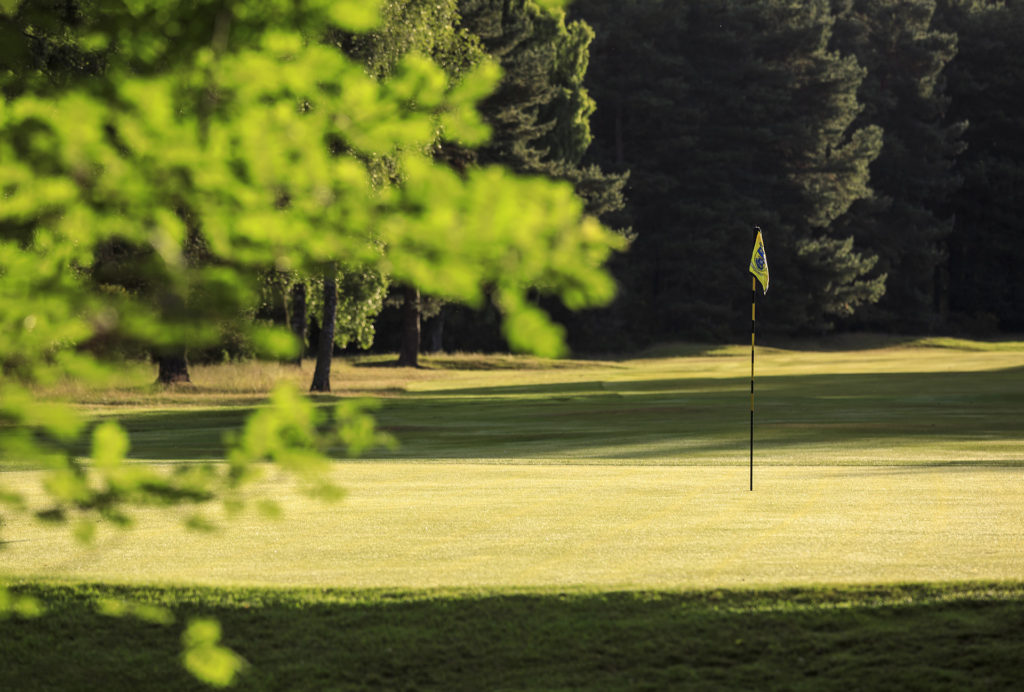
Greg Norman
Won his first European Tour event here in 1977. Frequently appearing in the Top 25 Heathland courses, tipping the balance as the best heathland in Scotland. Old Tom Morris said ‘I think this is the most beautiful inland green I have ever seen.’ This was just after he’d sunk a long putt on the last green to win his friendly match against the then club captain.
This classic mature golf course with its unique design mix of MacKenzie and Braid is a pleasure to play. I can’t wait to get back.
For more innovative, fun unique golf content, please subscribe to my social media channels
Instagram @sarah_thetravellingladygolfer
Twitter and Facebook @golfgurugroup
Interested in this golf club, or any in this series, or wish to be featured in the future, please email me on sarah@golfgurugroup.com

C – Carnoustie
GB&I Golf Course Reviews – Z to A
I am showcasing one golf club a day across GB & I over 26 days – in reverse alphabetical order. Full write up and more images can be found on http://golfgurugroup.blogspot.com.

Carnoustie Championship
Links House, Links Parade, Carnoustie, DD7 7JE
I was given the opportunity to visit Carnoustie a while back. Subsequently I took a number of clients and again revisited a couple of years ago, just before the Open in 2018.
Carnoustie is the name of the town in which sits this well known championship course. In fact there are three golf courses here, but my focus is on Carnoustie Championship. A double C if you like!
It is unclear where the name Carnoustie came from. Most likely it is from Scandinavian nouns of Car and Noust, meaning Rock and Bay respectively. Another story. The Battle of Barry in 1010 where a Danish General invader, Camus, was put to the sword by clansmen led by Scottish King, Malcom II. The Norse Gods were not happy at the loss of their favourite warrior. To show their displeasure they cursed the neighbourhood and released thousands of crows on Barry Sands. Colonising the locality it became known as Craw’s Nastie, corrupted to Carnoustie. As the village evolved into a borough in 1899, three crows flying was adopted as the crest for the area.

Of the Championship course itself
It has been noted that golf has been played here since 1500, with the present course being mapped out in 1850. Old Tom Morris extended it twenty years later to 18 holes. An extensive redesign was made by James Braid in 1926. However, it was felt his design did have a weak finish so it was a local man, James Wright who we can thank for the closing holes! Wright was drafted in ahead of the 1937 Open Championship. The course as we know it has pretty much remained the same for the last 80 years or so. In fact, it is not a course that flips its holes around when a Championship is played here. There are no airs and graces at Carnoustie, it is what it is. Take it or leave it. Most will take it, and enjoy it, even if they don’t score well.
As you stand on the first tee of the Championship course, the hotel behind you, you’re pretty much out there alone. The Tee box, despite it proximity to the clubhouse and Links House is almost in the middle of the course, or so it seems. You just know that people can see you from the hotel and are most likely watching too. But as it is far enough away, it doesn’t bother you. You ‘get into the course’ from that very first hit. You hit your drive, into a reasonably large area and you can forget the rest. You’re off and into the bosom of the course almost immediately.

Barry Burn
Makes a menacing appearance early on, but slinks back into oblivion until the closing holes. It is a relatively flat course, quite open and the weather is in play pretty much all the way round.
When you look at the course on televisions, you see the long whispy grass taunting your every shot. But actually down on the ground, the course is in exceptional condition and you can see clear cut fairways. Hogans Alley, 6th hole a par 5 SI2, 485/520 yards is good demonstration of this. Although a relatively narrow fairway, the 1953 Open Championship winner, who has been honoured with the naming of this hole, showed the way when hitting it straight down the middle. As golfers we often hear, just hit it down the middle. Not an easy feat at the best of times, but when confronted with a narrow landing strip, the task appears near impossible.

I will be honest with you.
I never really quite understood the nerves of some golfers, I’m a happy hit and play golfer. But even I had a little heart flutter on that hole the first time I played it. I did manage to get it where I wanted, in the middle. Needles to say subsequent games have never yielded such good results. Doing it once was clearly a fluke, replicating it is what makes a good golfer!
Playing Carnoustie
Was one of the rare moments where I had done some research before visiting. Being such an iconic course, I wanted to make sure I didn’t miss out on any experiences. You know how it is when you go on holiday only to return home 2 weeks later being told you should have visited…..
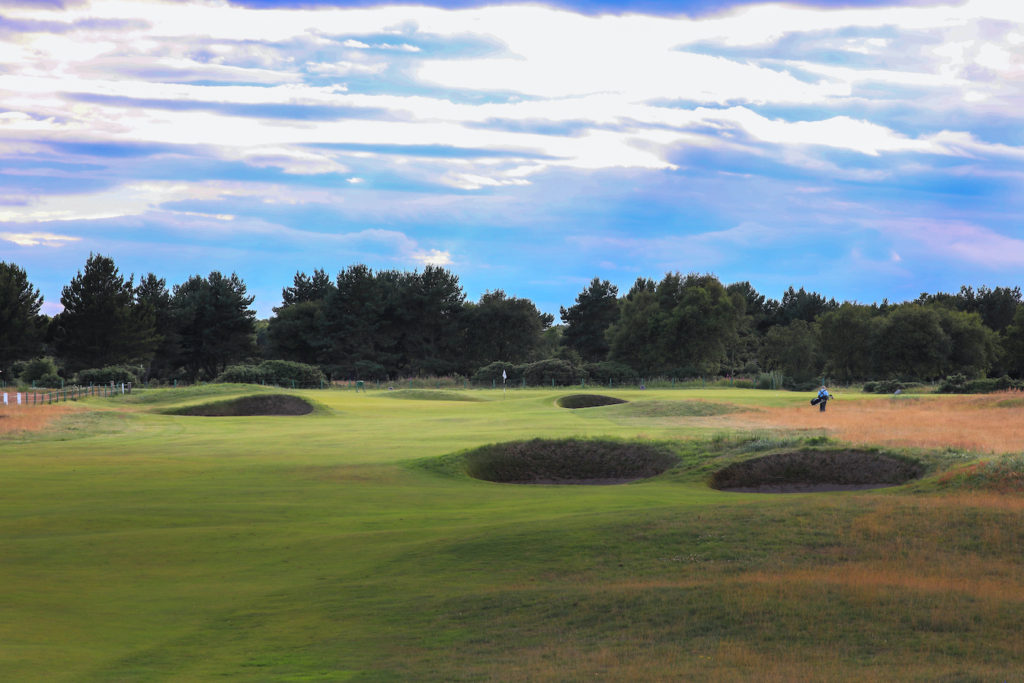
I had read up about the Spectacles on hole 14, and was keen to see them in person. A par4/5 at 375/476 yards SI1. The first time I saw them I wasn’t playing, so I was less than impressed. The next time I saw them was as I stood there with a club in my hand. I swear those bunkers had grown overnight! A good par 4/5 they don’t come into pay until about 50 yards short of the hole. In fact, despite their size, they almost sneak up to you. I have not had the pleasure of landing in them yet. Probably a good job as I might still be in them now, with their high sides and uninviting shot to the green. Most likely I’d go out backwards, maybe even with a putter if allowed!! Call me chicken or call me sensible.
To be honest getting to hole 14 is the start of any potential card wrecking day. Whilst I do love this course, I also totally respect it and play it using all my shots. I really love hole 16. The start of Barry Burn making its persistent appearance again over the next few holes. A par 3 at 212/225 yards, SI 13, which looks so inviting and plays more than I have even given it.

Those Carnoustie bunkers
Are in play all around and the Barry Burn sliding in from the left. I always feel as though I can get on the green and pop it in for a birdie. That hasn’t happened yet! I did sneak one in between the bunkers on the left once and it happened to roll close to the green, more good luck than good play if I’m honest!
Then I think I must have taken 3 putts – but thats another story for the 19th!
The greens are generally quite large at Carnoustie, they are short cut and roll like anything – or have the days I’ve played! Carnoustie is one of those places that you look at an aerial picture of and think, what’s the problem?
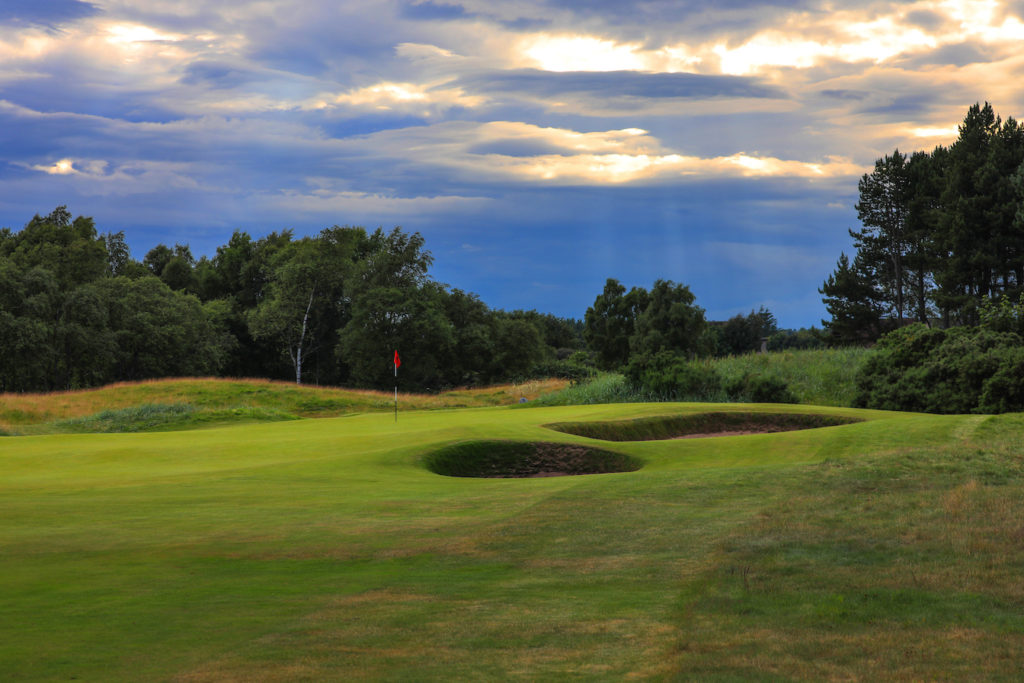
The oldest Ladies Club in the World
Is at Carnoustie with gender discrimination being a nasty word. That’s the only time ‘nasty’ should be used when referring to this golf course. They have a healthy ladies section and I have always been pleased to see this continues to be the case.
It would be rude of me not to mention the closing holes. Hole 17 a par 4, SI5, playing 364/473 yards. I do recall going in Barry Burn on the 17thwith my second shot A horrible little scummy things barely getting off the ground. I was gutted, even more so when I got close and realised how deep it was with my ball was in sight but out of reach. Carnoustie beat me that hole fair and square. Placement is key to getting any score here and not getting dragged into Carnoustie’s golf abyss.
To me, hole 18, par 4 SI 11 374/444 yards appeared less daunting, although still slightly narrow. Barry Burn on this closing hole has seen many a great golfer weep, John Van de Velde being the most notable of them all. But I’m not going to write about him, you probably know already, and I don’t want to end on a negative!

The key is navigation
And not to be too greedy. I did OK here, but I haven’t experienced the wrath of the Barry Burn on this final hole – yet.
Me, I’m looking forward. I’m seeing the hotel for some welcome food and drink. Now you can relax in the Links House too. The hotel is not owned by the golf club, it is a separate organisation, but has a close working relationship.
With the AIG Women’s Open playing here in August 2021, I can’t wait to return. If only to see if I can relive my one and only straight drive on Hogans Alley, or to see if I can continue to avoid spectacles. But most importantly to see if I can conquer these closing holes – or at least play to my handicap! Whilst there I also hope to experience the lovely Scottish hospitality at The Rookery and to look around the now completed Links House. The latter still under its finals stages of construction when I last visited.
For more innovative, fun unique golf content, please subscribe to my social media channels
Instagram @sarah_thetravellingladygolfer
Twitter and Facebook @golfgurugroup
Interested in this golf club, or any in this series, or wish to be featured in the future, please email me on sarah@golfgurugroup.com
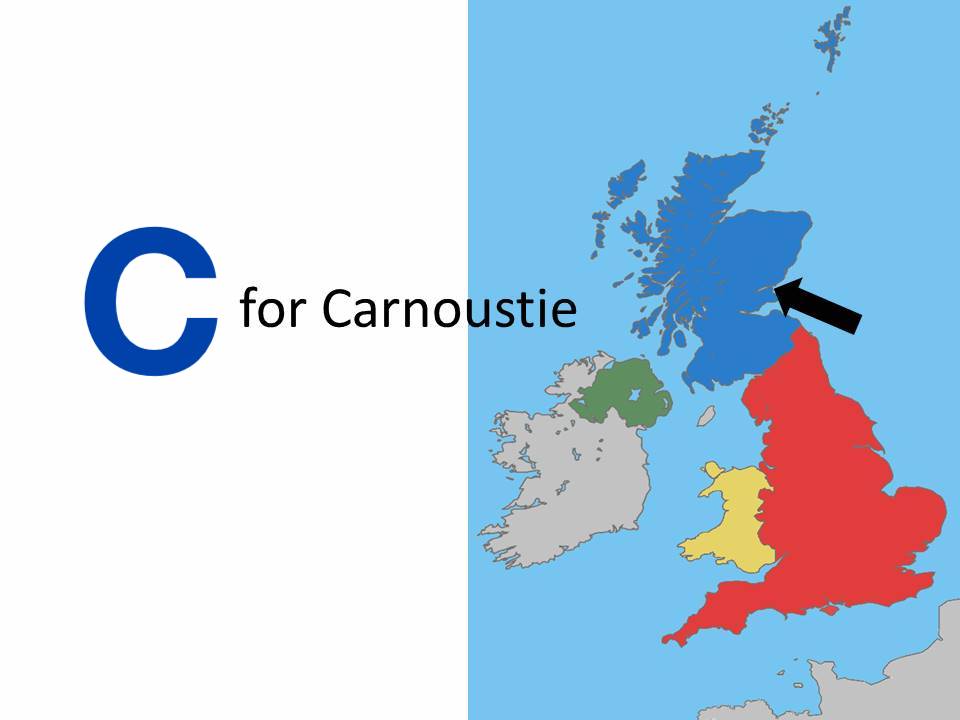
D – Donegal
GB&I Golf Course Reviews – Z to A
I am showcasing one golf club a day across GB & I over 26 days – in reverse alphabetical order. Full write up and more images can be found on http://golfgurugroup.blogspot.com.

Donegal Golf Club
Murvagh, Co. Donegal, Ireland
Does this golf course have it all?
From dead bodies to ancient food storage. From ocean side golf holes to mountains views and Forests.
Founded in 1959
As a nine hole course closer to Donegal on land called Tullycullion. Hole 13 yards bears the name of the former sight as it is in view from the 13th green.
Often referred to as Murvagh, Donegal golf club moved it current location in Murvagh in the early 1970’s. Eddie Hackett designed Donegal with 2 loops of nine holes taking inspiration from Muirfield. Not out and back as some 18 hole courses, but an inner and outer ring of nine holes each.
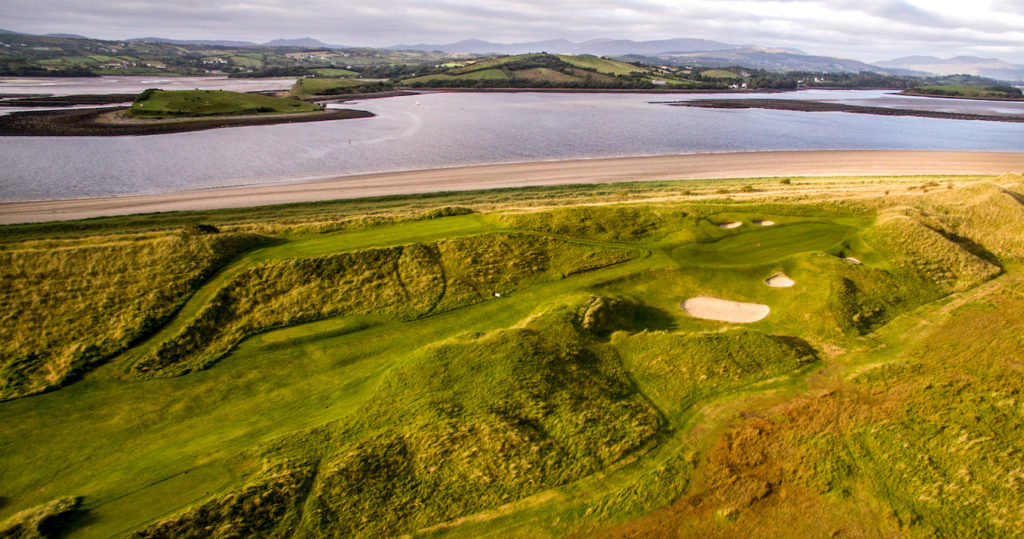
Eddie Hackett
Is known for saying “I find nature is the best architect, I just try to dress up what the Good Lord provides.” Going from hole number 13 a par three and the shortest hole on the course to hole number 14 a par five of 504/565 and the longest hole on the course. Testimony that Eddie Hackett did indeed within the the natural canvas as presented to him.
The par 3, 5th is their signature hole, called Valley of Tears. I wonder how it earned that name! It may be the lack of fairway, target golf is very much in order for this hole! That said the green is quite large but come up short and there is a deep bunker to catch you out. Statistically this is also the hole that has highest number of hole in ones on the course, so a mixed bag for sure.

The original design
Has had some tweaks from Pat Ruddy who is still engaged to offer advise as needed. Ruddy has lengthened holes and done some remodelling on others, but largely the layout remains as it was from Eddie Hackett’s original design.
My opening gambit of ‘does the course have it all’ is demonstrated with its location on the Murvagh peninsular. Located near Murvagh beach, with its blue flag status, adds to the drama and contrast of the Bluestack Mountains. Ditches dissect the course in places and there is also woodland to encounter. Add the obligatory bumps and humps as if an oversized mole has left its casts of yesteryear, now grassed over. All this is in play at some point or another.
The history of the site belies it’s short history as a golf course. The 17th called Souterrain hides a series on underground chambers. Whilst not entirely sure what these chambers were used for, it is likely they were used for food storage. Other theories were to take refuge when under attack.

The first green
Was unearthed as a burial site for some unfortunate sole who’s remains were found during excavating the course in the 1990’s. This unique location also lends itself to stories such as the hole number 6. A par 5 493/514 yards with its views of The Hassons. A location in the 18th century where Irish Emigrants boarded the ‘coffin ships’ bound for a better life in the Americas.
Hole number two a par 4, 377/466 yards is the only hole that faces West, into the prevailing wind. With bunkers in play on the approach there is no let up if that wind is blowing. As you would expect the wind does come into play as it swirls around. Having the inner and outer ring does afford some level of respite on the back nine, but not a lot on the day I played!
No such story in Ireland
Would be complete without fairies or leprechauns usually whilst enjoying a pint of the black stuff. Hole number 11 is called Fairy Rath. A Rath is a ringfort, often associated with fairies and leprechauns. It has been speculated that one such ringfort existed just before the green on the 11th. Now a big dip to catch the ball on the approach. I could have used some of the infamous ‘luck of the Irish’ with my approach shot which didn’t land on the green but in the swell giving myself a tricky recovery shot.

Hole number 8
Has been voted the best Par 5 on the West Coast of Europe. It’s elevated tee and deep swells add to the drama of the blind shot to an elevated fairway.
Darren Clarke, 2011 Open Championship winner and member, states that Donegal is ‘one of my favourite courses in the World’
And who am I to argue!
For more innovative, fun unique golf content, please subscribe to my social media channels
Instagram @sarah_thetravellingladygolfer
Twitter and Facebook @golfgurugroup
Interested in this golf club, or any in this series, or wish to be featured in the future, please email me on sarah@golfgurugroup.com

E – Enniscrone
GB&I Golf Course Review – Z to A
I am showcasing one golf club a day across GB & I over 26 days – in reverse alphabetical order. Full write up and more images can be found on http://golfgurugroup.blogspot.com.

Enniscrone Golf Club
Enniscrone, Co. Sligo, Ireland
Enniscrone also spelt Inniscrone, officially named Inishcrone is in County Sligo on the North West Coast of Ireland. Forming part of the Wild Atlantic Way, this small tourist town is a big attraction for golfers too.
Starting from humble beginnings.

1918 marked the beginning
Of Enniscrone Golf Club. In 1922 medal competitions were held over three Enniscrone locations; Barta, Kilcullens Field and Scurmore Hotel varying from 9 to 4 to 6 holes respectively. In 1930 a nine hole layout was established on flat land at Barta and the course opened to membership for a fee of £1. Forty eight members joined when it opened on St Patricks Day 1931.
In 1933 a greenskeeper was employed with his horse drawn fairway mower. In 1947 a new clubhouse was built at a cost of £400. Due to war, emigration and economic depression Ireland experienced a down turn and by 1959 there were only 14 club members. In the sixties with the building of Bellacorick power station and the Moy drainage scheme bought in much needed new blood. By 1969 membership had built back up to over one hundred.
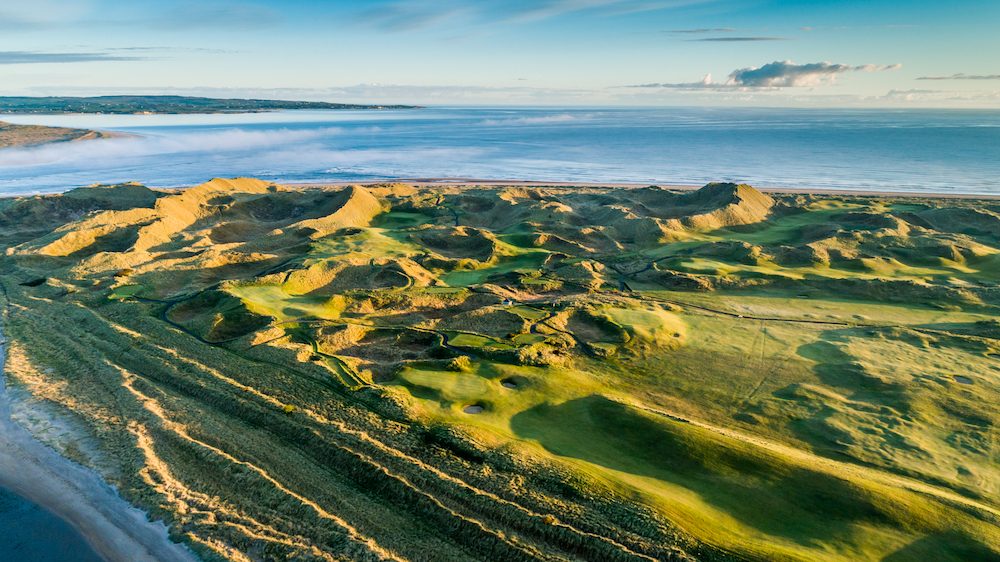
Livestock roamed the course
And the members wandering eyes were turning towards the dunes with dreams of an 18 hole links course. In 1970 Eddie Hackett was drafted in to design the course. Working alongside the committee, holes were designed with the dunes to blend into the natural terrain. In 1972 12 miles of fencing was purchased to keep the animals at bay. The first ball was driven by Eddie Hackett in August 1974. Gaining such accolades as “an undiscovered gem of a links.” By 1999 Enniscrone was ready for the next chapter in its evolution. Donald Steel was commissioned to reroute the course directly into the Dunes. He added 6 more holes and turned some of the original layout over to the new nine hole course, Scurmore. The clubhouse had an extension and the new course was re-opened in 2001.
The 18 hole course is called the Dunes measuring 5723 to 7029 yards. Labelled as a dune land course, its look is more akin to the moons surface. With huge dips and hollows being dominated and overshadowed by the dunes, some of the highest in Western Europe.
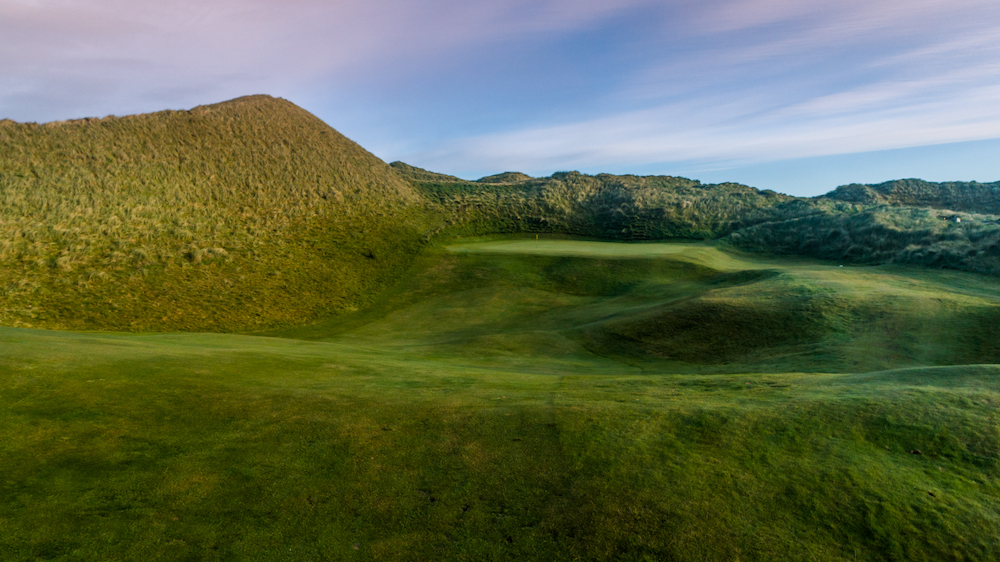
When you’re sat in the clubhouse
And it is blowing a hooley out there, you might be forgiven for thinking, maybe tomorrow. But there was no tomorrow for me, it was that day or no day, and I was not going to miss out on playing Enniscrone!
It took a few holes to get into the swing of things, literally! Dog legs, elevated greens and those dunes surrounding a punch bowl green – and that was only on the first hole.

The whole course
Was in such amazing condition. Tee boxes were like islands of vibrant green amidst the long swaying grass. A dot to dot of tee boxes heading in the direction of the fairway and putting surface in the distance.
Whilst the dunes have been noted as some of the highest, the dips added to the drama and depth of the dunes too. Most likely remnants of the ice age, those swells must have been deep icy ponds before receding to create the natural crators of today.
Stunning views over Killala Bay, the Moy Estuary and Bartragh Island one way. In stark contrast are the wild and rugged Nephin and Ox Mountain ranges. There is always something to look at when playing Enniscrone.

Hole number 12
Is the hole that always sticks in my mind. I was starting to get used to the near perfect fairways, the short cut greens where the ball may, or may not, stay up. But nothing prepared me for the 12th. I recall standing there thinking blimey, if I miss that I’m into a whole lot of trouble!
Called Cnoc na gCorp translated means the Hill of Hunger or Hill of Bodies. I was determined not to be a casualty of this beautiful hole. Despite it luring me into its green, carved out of the side of a sand dune! A par 4 of 262/347 yards SI 16/3. The exit off the tee was much more thought provoking from the back tees than the forward ones.
But the shot to the green was the same challenge. A huge swell in front of the green before your eyes are drawn up to the green. Seamlessly moving from a fairway, to the apron to the green was a trick of the eye as you weighed up your approach shot. It has to be said, I’m not one to over think things, so I just hit it to the green after a less than perfect drive. To my shock it ended up on the dance floor.
Other holes had almost split level fairways, pot hole bunkers and the inevitable lunar links feel. The bunkers, were often quite deep and occasionally in multiples of 2 or 3 across the fairway at an angle offering little respite with any wayward shots. They often complimented the other side of the fairway which might challenge you with a deep swell or high dune.
Playing Enniscrone was a delight, and yes I did enjoy the Irish hospitality at the 19th too!

F – Flamborough Head
GB&I Golf Course Review – Z to A
I am showcasing one golf club a day across GB & I over 26 days – in reverse alphabetical order. Full write up and more images can be found on http://golfgurugroup.blogspot.com.

Flamborough Head
Lighthouse Road, Flamborough, Bridlington, East Riding of Yorkshire, YO15 1AR
When you drive up to Flamborough Head Golf Club, the first thing that strikes you is the Tower. Situated to the right of the clubhouse as you look towards the North Sea. This Old Beacon was built in 1674 and in actually located on the golf course itself. It is the oldest surviving lighthouse in England.
Flamborough Head is arguably an unusual choice for the Alphabet golf series, but its isn’t always about the best golf courses; the named golf courses. To me it is about the whole package. Here you are always certain of a warm and friendly welcome in good old no nonsense Yorkshire fashion. In fact, one of its slogans is ‘the friendliest club on the coast’

Pitched atop a cliff
This 18 hole links course brings in some challenges of its own. As well as some beautiful views across the North Sea. Overlooking the site of the Battle of Flamborough Head fought on 23rd September 1779. Hole number 13 carries the name of American John Paul Jones. Jone’s ship, the Bonhomme Richard defeated the British man-of-war Serapis. The course occupies, in part, a former farmhouse where he is reputed to have stayed.
The golf course was founded in 1931. With its tricky location and steep drop off cliffs, I am informed that this part of the coast doesn’t suffer too much from erosion. Which is great, as it would be a shame to lose it to the sea. it is fair to say there are a couple of up and down holes. In the main, I don’t believe this detracts from the overall experience of playing such a location. The weather does play a big part in the game, as the wind can whip around and off the North Sea.

The beacon
Is located after you have played hole 4, a par 4 measuring 417/439 yards, SI3. Two good accurate shots are required before encountering the split level green. After putting out, take a short walk behind the green and circumnavigate the tower, just for fun. Can you imagine having to light a fire that high up to give boats the warning of Flamborough Head jutting out into the sea? East Riding Council wanted to open it up as a museum, but for now that idea is on hold. Friends of the Chalk Tower are behind this scheme and are keen to see it succeed.
Hole 6, whilst a relatively easily achievable shot, is fraught with danger if slightly off kilter. A pond, a bunker and the deep rough make this SI 16 par 3 hole of only 136/141 yards a decent challenge, especially when the wind is in play!
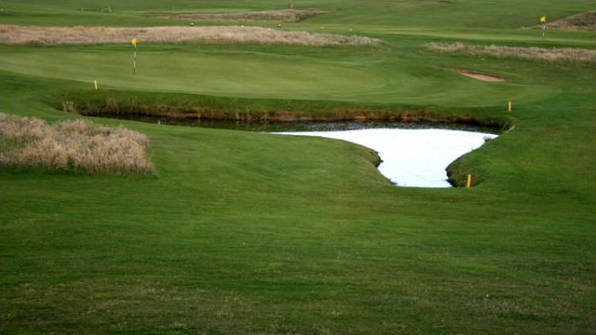
The Signal Hole
Hole 10 is a risk and reward shot, again a par 3. From an elevated tee this 146/148 yard hole is covered front and side with bunkers. Be brave or go home on this pretty hole. Once on the green it really depends on where the flag is, as this is as this is a two tier green.
Another hole of note is hole number 11. My notes say lovely hole, the stats say differently! Its is a long par 5 of 505/552 yards. A blind shot over the marker post, for your drive needs to be straight. Subsequent shots are also not easy as you’re shooting towards the North Sea again. Too short and the ball gets caught on the slope and comes trickling back to you. Too long and its rubbish on the right and at the back – oh and then of course you have the cliffs behind and to the right also.
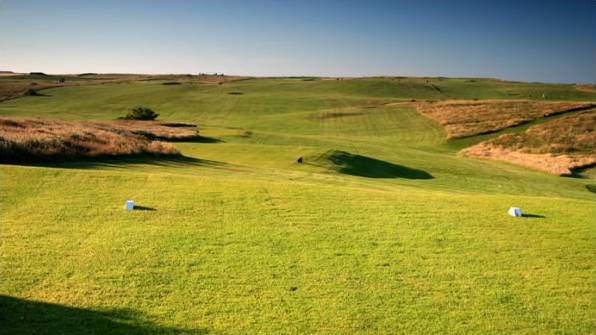
With elevated tees, ditches running around the course and tiered greens you’re not in for an easy ride playing here. For a relatively flat course, whose overhead view does nothing to show the game needed to score well, I think it is worthy of a place in this series.
And one of the best bits about playing Flamborough Head. Fish and Chips – so typically British, so typically Yorkshire, and so tasty it is worth the trip.

G – Galway Bay
GB&I Golf Course Review – Z to A
I am showcasing one golf club a day across GB & I over 26 days – in reverse alphabetical order. Full write up and more images can be found on http://golfgurugroup.blogspot.com.

Galway Bay
Renville, Oranmore, County Galway, Ireland.
There is something quite familiar about Galway Bay, and until recently I couldn’t quite put my finger on why. Then it came to me! Every year we sing about Galway Bay along with the Pogues and Kirsty MacColl in the classic Fairytale of New York!

Arriving at Galway Bay
I genuinely had no idea what I might expect, I don’t always like to research where I’m going so it doesn’t cloud my personal judgement or generate any preconceptions. So I didn’t know if this course was a links, parkland or heathland.
I was playing some of the courses along the Wild Atlantic Way with a few other journalists when we stopped at Galway Bay. A warm welcome was upon us in no time in a bustling modern clubhouse having a quick warm up before playing. When I say warm up, I mean drink in huge coffee cups, not on the driving range!

Ready to play
We set off up hole one and back down hole two, before moving away again from the clubhouse. This time in the direction of the Atlantic Ocean. Whilst being so close to the Ocean, it isn’t a links course. It is a good strong parkland course laid out to enjoy the sea views as well as the sea breeze.
Former Ryder Cup player and Snr British Open winner, Christy O’Connor, Jnr is the golf course designer. His plan was to create a course in tune with nature, whilst accommodating golfers of all abilities. A man with a plan, he drew from his vast experience as golfer. With the rugged Galway Bay as the backdrop, trees bunkering and water hazards were finely tuned to give us the golf course of today.

I recall the putting surfaces to be consistently good.
That in itself can’t be an easy task bearing in mind its location and the ever changing wind direction. Playing the eleventh hole a par 4 333/423 yards, SI 2/3 was good fun with its drive over water to a dog leg left. Bunkers aplenty and the clubhouse in sight.
But turn back away again to take on the 12th, a great hole playing quite differently from the forward and back tees. 384/469 yards SI 14/1 and a par 5 forward, par 4 back tees. It is a hole to bat cleverly and play for position. A dog leg right as it drops down the hill to the green with the Atlantic in front of you as you take on the water to the green. This hole is often featured amongst the top 18 holes in Irish golf. With views to the Burren, Co Clare; one of six nations parks in Ireland, the Aran Islands, Connemara and Galway City.

There were a few holes
Where the back and forward distances differences were quite large, with the par threes, being a little more even for distance on the front nine. With water featuring over 10 of the 18 holes, maybe that’s one of the reasons?
My game that day was a bit up and down, a few blobs then pars, with the back nine giving me some points back after a very lack lustre front nine! But I loved the feel of this club, playing a great parkland golf course with its natural beauty was a bonus after the welcome received in the clubhouse.
Nine miles away is Galway, City of the Tribes and the Cultural Heart of Ireland. And the heart of a good night out too!

H – Hankley Common
GB&I Golf Course Review – Z to A
I am showcasing one golf club a day across GB & I over 26 days – in reverse alphabetical order. Full write up and more images can be found on http://golfgurugroup.blogspot.com

Hankley Common
The Clubhouse, Tilford Rd, Farnham
It has to be said the time I played Hankley Common it was absolutely tipping it down. Known for being one of the best courses in that area that can stand that level of water, it was a bit of a non-brainer that we play Hankley Common on such a wet weekend. To this day, I am sure the pro was completely bemused at our request to play. Non of the members were daft enough to venture out that day!
The wonderful free draining turf on this pretty heathland course was a god send that day. We were, despite the wet stuff from the sky, able to continue play without too many hinderances.

The original nine holes
Date back to 1897. In 1922 James Braid added a further nine holes, encompassing the layout and natural beauty of the terrain. 10 years later Harry Colt was bought in to add length.
Bobby Locke described this heathland course as a ‘closest resemblance to playing a links’ with other such accolades as ‘one of the best inland layouts in Britain’

Playing Hankey Common
Was not always an open expanse experience, in so far as the fairways are often tree lined. The greens were a decent size and nicely and receptive too. The fairways seem to sway their way around the course, like chiffon in the wind, only broken up by the bunkering and heather. Some of the bunkers were of such a depth that required thinking about! The odd large establish tree came into play as the course criss crossed around the common with ease. To be honest everything a good golf course can offer is here at Hankley Common. But the rough of heather and pretty much everything else was incredibly punishing!
Whilst playing Hankley Common I didn’t feel as though I was in a mass expanse of nothingness at any time. It was very neat and tidy as one navigated around he course with ease. Dog legs and the colour contrasts were just beautiful to feast your eyes upon. And just as you think you’re on the home ward stretch, hole 18 throws up a tough finish. With its dip in front of the green- maybe it was because I was soaked by then, I just remember looking at the clubhouse thinking – Lumumba!

Hankley Common
Is owned by the Ministry of Defence. Set in 1400 acres, the surrounding area is designated as an area of special scientific interest. The common has been the site for some classic films such as James Bond’s, the World is Not Enough and Die Another Day. Michael Fassbender starred in Macbeth here and Michael Vaughan’s The Kings Man was another to be filmed here. In fact many a movie star has trodden the soil of Hankley Common over the years. Wildlife, flora and fauna are common place here with the Golf Club adopting the common fox as their logo. The golf course occupies the West side of this Surrey heathland location.

I – Isle of Purbeck
GB&I Golf Course Review – Z to A
I am showcasing one golf club a day across GB & I over 26 days – in reverse alphabetical order. Full write up and more images can be found on http://golfgurugroup.blogspot.com. For more innovative, fun unique golf content, please subscribe to my social media channels
Instagram @sarah_thetravellingladygolfer
Twitter and Facebook @golfgurugroup

Isle of Purbeck
Corfe Rd, Studland, Swanage, BH19 3AB
When you’ve got a great course and some interesting history, you know you’re onto a winner for a good day out.
Founded in 1892
And originally opening as a nine hole course on Dene Hill in 1893 with 40 members, whose membership was just a guinea. In todays money that is one pound and five pence, pre decimalisation it was 21 shillings (a shilling being 5p).
Fast forward to relative recent history and its new owners being Mr and Mrs Darrell-Waters. Mrs Darrell-Waters, better known as Enid Blyton, the prolific children’s novelist maybe better known for characters such as Noddy and Big Ears. Taking inspiration from local characters ‘PC Plod’ was based on a cheerful, well known local policeman in the 1950’s.

Enid Blyton
was good golfer and was elected Lady Captain in 1951. During the Darrell-Waters ownership the course was extended to the 18 holes. Enid Blyton’s putter is still at the club awaiting its new display cabinet.
Next in line of ownership was another punchy name, Mr H B Randolph a recent retiree from his ownership of the Wilkinson Sword Company. A keen hobby golfer himself, he seized the opportunity to create an impressive clubhouse and bought out the land lease plus additional land. The 27 holes of today and the elevated clubhouse overlooking Poole Harbour are testimony to his desire to showcase the spectacular views. Uniquely the building material of the clubhouse is Purbeck Stone inset with giant fossils.

The Sword Bar
Was created in memory of his first wife. Randolph gave many swords away. There is a replica of the Golf Flaming Sword as presented to His Imperial Majesty Haile Selassie, the “Lion of Judah’, Emperor of Ethiopia. In another room is the Sword of Stalingrad, the original being presented to the people of Stalingrad during WWII. Many more swords decorate the clubhouse.
But what of the course itself?
I played 18 holes. Hole number 1 and 2 go away and back to the clubhouse. Crossing back in front of the club house is when the fun really starts. From hole 3 you are walking away with the club behind you. This heathland course is pretty in its own right, but once you get to the fifth, those views over towards Poole gives the game away as to what a special place you are in.

Holes 5 and 6 are the furthest away from the clubhouse on the front nine. I remember them being so peaceful. I was playing towards the end of the day, by myself just carrying my bag and enjoying the peace and quiet. It suddenly struck me that I was completely alone, just listening to the world go by as I hit my golf ball towards the dip to the 5th green.
As you play around the course
You cross around the back of the club house after hole 7. The golf course plays a little like a links course, but is probably best described as heathland, with a links feel. The course splays out returning to wrap its arms loving around the clubhouse and embrace the vista view once more for the post round drinks.
Maximising the space, the holes play in different directions, thereby offering a complete challenge in golf.
The late Peter Allis said
“I’ve always felt the Club is certainly one of the most spectacular in the whole of the UK and the general ambience of the Club and course is absolutely delightful.”
I guess he was in good company with his thoughts as the late King Edward also declared the view from the fifth tee as one of the finest in British golf.
Purbeck is a peninsular of land bordered by water on three sides. The English Channel are to the South and East. The Dorset Coast, the Jurassic Coast with its high imposing cliff tops adds drama to this wonderful location.

J – John O’Gaunt
GB&I Golf Course Review – Z to A
I am showcasing one golf club a day across GB & I over 26 days – in reverse alphabetical order. Full write up and more images can be found on http://golfgurugroup.blogspot.com.
Look out for the daily influx of unique, quirky, amazing golf courses in this series, and please do comment, like or share if you want to start planing ahead. For more innovative, fun unique golf content, please subscribe to my social media channels
Instagram @sarah_thetravellingladygolfer
Twitter and Facebook @golfgurugroup

John O’Gaunt Golf Club
Sutton Park, Sandy, Bedfordshire, SG19 2LY
The imposing Mansion House enjoys panoramic views as it presides over the golf courses and grounds of the John O’Gaunt Golf Club.
Dating back to 1859, rebuilt after a fire in 1825, the mansion house is the clubhouse serving the two 18 hole golf courses and practice facilities.
Originally the golf course was a 9 hole in a different location. The War Office took over the nine hole, ploughing up 3 of the holes for crops. The remaining six had ditches dug into them to hinder aircraft from landing.
In 1948 a new location was sought for the then known Mid Bedfordshire Golf Club. The 300 acre Sutton Park was found to be the perfect location with its picturesque countryside views and established lime trees, some still standing to this day.

The front nine
Of the John O’Gaunt course were designed by W G Groves, a scratch golfer, with the back nine being designed by Fred Hawtree. Hawtree went on to design the second course, Carthagena, but our focus for today is the main course, John O’Gaunt.
With the purchase of Sutton Park came the somewhat dilapidated mansion house and established gardens designed by one of Capability Browns contemporaries, Humphry Repton.
As I haven’t played John O’Gaunt, my guest writer for letter J is Phil Millington:

As I arrived at the club
Ready to represent my club in a Seniors Scratch Team match, I was greeted by the clubhouse which has the air of an old country hall, with its grounds now converted into two golf courses, the John O’Gaunt main course and the Carthagena course. As you walk in you get the impression of history at this club.

My match was played on the John O’Gaunt course and it was the first and only time I’ve played at the club; in Mar 2020 (before Covid truly arrived on the scene). The course itself is a gently undulating mature parkland layout with many tall old imposing trees lining the fairways. Positioning of your shots in the right part of the fairway is key to producing a good score on many of the holes, otherwise your course management skills will be tested for sure. For the time of year the course was in really good condition and well presented, with the greens being suitably paced and true.

To sum it up for me
Almost a year further on, I find I can clearly remember all but maybe one or two holes; dog legs both ways, raised greens, some holes slightly uphill, some downhill. The John O’Gaunt course is recognised as the No.1 course in Bedfordshire and for me the fact I remember the course so well is truly the sign of an interesting course. One that I look forward to playing again in the future.

K for Kington




